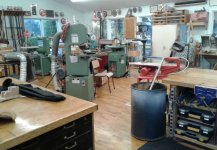I’ve had my Festool track saw for about 3 years now but all I have ever done is cuts with the blade set at 90 degrees.
I now want to make a cabinet with mitered corners. I could simply make 90 degree cuts and then bring it to the table saw to make the miter trims. But if it is no more difficult to make 45 degree angle cuts with the track saw, then that would be preferable.
Is there anything I have to watch out for?
I will be making 16” x 16” blanks, mitered at two opposite edges to be joined with about a 6” x 16” piece on both sides. This will be wall mounted and used as an night stand. There will be two; one on either side of the bed.
I have a 32” and two 55” tracks. For this, I would probably use the 32” unless there is some reason not to.
I have two TSO squaring arms with parallel guides also.
Any tips or cautions would be appreciated.
I’ve done this type of joint many times. I usually cut to the exact size first with the table saw blades set at 90 degrees. Then I use a sacrificial fence and cut off the miters.
But I am planning on a couple of very wide low cabinets (72” wide x 16” deep). Trying to make the miters like I have been on a piece that long would be very challenging and I would likely fail. I would need a sliding table saw to do that easily. (Or the track saw.)
So the night tables are sort of a trial balloon—for the learning curve.
Any tips would be appreciated.
Packard
I now want to make a cabinet with mitered corners. I could simply make 90 degree cuts and then bring it to the table saw to make the miter trims. But if it is no more difficult to make 45 degree angle cuts with the track saw, then that would be preferable.
Is there anything I have to watch out for?
I will be making 16” x 16” blanks, mitered at two opposite edges to be joined with about a 6” x 16” piece on both sides. This will be wall mounted and used as an night stand. There will be two; one on either side of the bed.
I have a 32” and two 55” tracks. For this, I would probably use the 32” unless there is some reason not to.
I have two TSO squaring arms with parallel guides also.
Any tips or cautions would be appreciated.
I’ve done this type of joint many times. I usually cut to the exact size first with the table saw blades set at 90 degrees. Then I use a sacrificial fence and cut off the miters.
But I am planning on a couple of very wide low cabinets (72” wide x 16” deep). Trying to make the miters like I have been on a piece that long would be very challenging and I would likely fail. I would need a sliding table saw to do that easily. (Or the track saw.)
So the night tables are sort of a trial balloon—for the learning curve.
Any tips would be appreciated.
Packard


